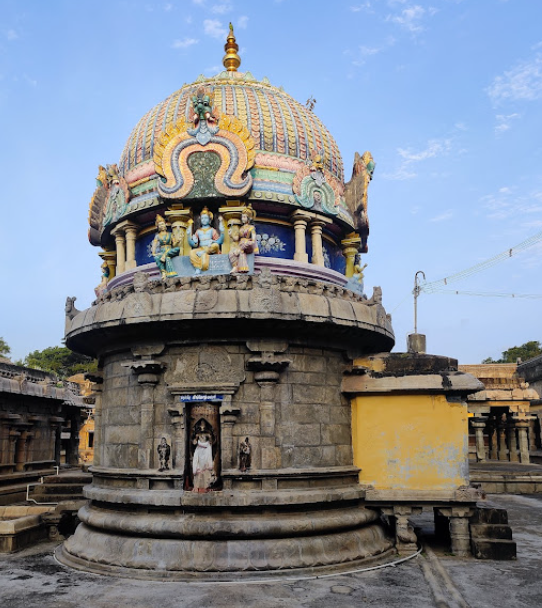In the celestial realm, the demon Pandasura tormented the Devas, prompting them to seek the protection of Mother Parasakthi. In response, the Goddess emerged from the Yagna fire, riding Her Srichakra Chariot and known as Lalithambika. Fueled by fury after vanquishing the demon, Lord Shiva advised Her to descend to Earth as Sripuravasini and perform penance to quell Her anger. Thus, Mother Lalithambika arrived at this place, where She engaged in penance and transformed into a calm and graceful form. During Her meditation, She created Vachinya and other angels of words, instructing them to chant Her 1000 names, which gave rise to the Sri Lalitha Sahasranamam, beginning with "Sri Mathre."
The temple features Lord Shiva as a Swayambulingmurthy. Notably, from the 21st to the 27th of the Tamil month Chithirai, the rays of the Sun illuminate the Lord, during which special pujas are conducted. An attractive sculpture of Sri Kshetrapuraneswarar can be found within the temple, while the Goddess appears both furious and graceful when viewed from different angles.
Sthala Puranam :
Sage Kashyapa had two wives, Kadru and Vinata, who prayed to Lord Shiva for children. In response, Shiva gifted each of them an egg, instructing them to keep it safe for a year. At the end of this period, Vinata's egg broke, resulting in the birth of Garuda. Kadru, however, hastily broke open her egg before the designated time, giving birth to a deformed child named Aruna, who later became the charioteer of the Sun (Suryan) and is associated with dawn.
Aruna was a devoted follower of Shiva and visited Kailasam daily. However, one day, Suryan mocked Aruna for his deformity, which prevented him from going to Kailasam. To escape further humiliation, Aruna transformed into Mohini, a beautiful woman, and worshipped Shiva. During this time, Indra saw Mohini and was enchanted, resulting in the birth of Vali, a character from the Mahabharata. Later, when Suryan learned of Aruna's transformation, he desired to see Mohini. Upon witnessing her beauty, Suryan too became enamoured and fathered Sugreeva with her.
Due to their misbehaviour towards Aruna/Mohini, Shiva cursed Indra, leading to his loss of the throne to Mahabali. Suryan, in turn, lost his radiance, causing darkness to engulf the universe. Desperate for forgiveness, Suryan sought Shiva's mercy, who instructed him to perform penance at Thirumeeyachur. As part of this penance, Suryan crafted murtis of Shiva and Parvati, placed them on the back of an elephant, and flew them to the clouds. This is why Shiva is known as Meghanathar (Lord of the Clouds) in this temple.
Despite Suryan's efforts, his brilliance did not return, prompting him to appeal to Shiva once more, this time in tears. His cries disturbed Parvati, who was deep in tapas and was about to curse Suryan to remain dark for another seven months. Shiva intervened, calming Parvati, who eventually relented. This moment of Shiva pacifying Parvati is beautifully sculpted in stone within the prakaram of the Meghanathar shrine, where Parvati is known as Shanta Nayaki.
As Shiva sought to pacify Parvati, the Ashta Vachanees (eight personifications of speech) praised her by reciting her 1000 names, which led to the origin of the Lalita Sahasranamam.
Significance : This temple is notable as one of only two Paadal Petra Sthalams (temples revered in the hymns of the Nayanmars) that houses a Siva temple within another Paadal Petra Sthalam. The other such temple is Vartamaneswarar at Thirupugalur, which is located inside the Agneeswarar temple. These nested temples are referred to as Ilan-koil and represent one of the nine structural temple constructions described in literary sources: Perunkoil, Karakkoil, Gnazharkoil, Kudikoil, Ilankoil, Manikoil, Alakoil, Madakoil, and Poonkoil.
Typically, a provisional temple (balalayam) is constructed before the main temple. However, the Sakalabhuvaneswarar temple was built as a balalayam for the Meghanathar temple but remained standing due to its beauty, even as the main temple was constructed.
Associations and Features : Several temples in and around Mayiladuthurai (18 km from Thirumeeyachur) are linked with Goddess Kali. This temple is also among them, believed to be a site where Kali worshipped Shiva, as did Mahalakshmi.
The temple, specifically mentioned in one of Appar’s pathigams, is self-contained as a Shiva temple, featuring a maha mandapam, separate shrines for the moolavar (main deity) and Amman (Goddess), Nandi facing Shiva, all usual koshtam deities, its own pranala (water spout from the garbhagriha), and a shrine for Shiva’s guardian, Chandikeswarar.
Tirumeyachur, particularly nearby Tirukodiyalur, is considered the birthplace of Saneeswaran (Saturn). As a result of the temple's puranam, figures like Aruna, Garuda, Vali, and Sugreeva are also believed to have been born here.
Historical Context : According to Appar's pathigam, the temple has existed since at least the 6th or 7th century during the saint's lifetime. The original structural temple is dated to the 10th century, attributed to the Chola dynasty, with subsequent renovations by Sembian Madevi and Rajendra Chola. Inscriptions within the temple reference various Chola kings and later Pandyas who ruled the region.
The temple predates the Meghanathar temple, evident in its architecture and the sculpting of the murtis. Many of the murtis and bas-relief sculptures appear more faded and less refined than those from later Chola artisans. Notably, a murti of Vishnu is present in the rear koshtam of the garbhagriha, depicted with folded hands, further indicating the temple’s age.
The outer wall of the garbhagriha features several koshtams that are empty, but they are adorned with exquisitely engraved toranams, captivating any admirer of temple architecture.
Administration History :
The Sakalabhuvaneswarar Temple was originally built by Ko Chengat Chozha, reconstructed in stone by Sembiyan Mahadevi during the Rajaraja Chola period, and later expanded during the Pandya period. In modern times, the temple underwent renovations with Maha Kumbhabhishekams in 2000 and 2015. It is currently under the administrative control of the Thirupugalur Velakurichi Adheenam.
